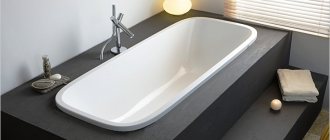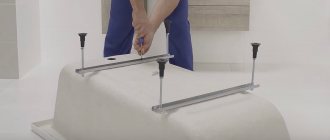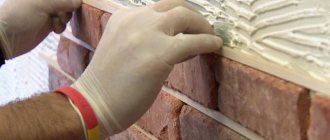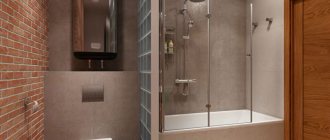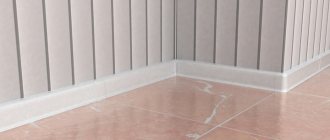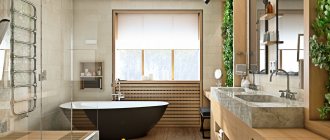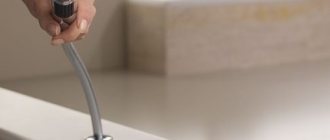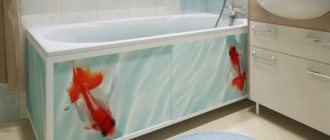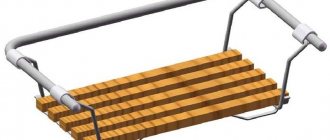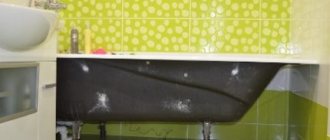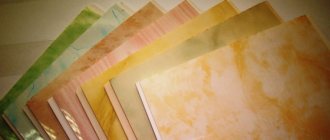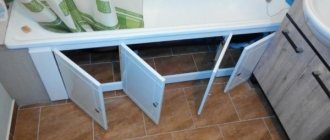No matter how hard you try to install the bathtub close to the wall, it will not be possible to do it perfectly. Since there are no completely flat walls in any house, one way or another there will be a small gap into which water will enter. Previously, cement mortar combined with oil paint was used to solve this problem. However, now there is a more modern and simpler solution - bath skirting boards. Let's consider all possible options for border design, as well as their features.
The bath skirting will protect the walls and floor from water and will become a harmonious decoration of the bathroom
Choosing a border to seal the gap
The absence of cracks near the sink and bathtubs without sealing can only be achieved by perfect alignment of the walls and floors, precise installation of plumbing fixtures and laying of tiles. It is not always possible to carry out work of such high quality, and without extensive experience it is almost impossible. Even after installing tiles and a bathtub by craftsmen, most often there remains a thin gap. The risk of water penetration, increased humidity and mold growth is greatly increased.
The choice of materials for sealing seams is not very large; there are several options for borders on sale. The most budget-friendly of them is self-adhesive tape, the more expensive ones are products made of ceramics, natural or artificial stone. It is necessary to choose the correct border size. When selecting the length, follow these recommendations:
- ceramic products - according to the width of the tile;
- plastic skirting boards - along the length of the side;
- border tape - for the entire length of the seam.
The width of the elements or adhesive tape will depend on the size of the gap. If the latter is less than 3 mm, you can use white silicone sealant to seal the seam. Gaps up to 5-6 mm are covered with a border 3 cm wide, larger ones - up to 3-6 cm. If the gaps are significant, they are first sealed with mounting foam or concrete mortar, and covered with the widest possible profile.
Flexible self-adhesive border tape
Tape border, or border tape, is an original material that allows you to seal the joints between the bathroom and the wall. The tape can be installed with your own hands; you don’t need any special skills for this. The downside of such a curb is its relative fragility (average service life is 3 years), but due to its low cost, replacing it will not be difficult. In addition to protecting against dirt and moisture, curb tape is used to give a finished look to the room - gluing the strip completes the repair. The plinth fits perfectly with an acrylic bathtub - which one is better to choose can be determined depending on its shape (oval, square).
The elastic baseboard for the bathtub is made of special plastic with various polymer additives. The reverse side is coated with liquid butyl adhesive covered with a peel-off film. The material is sold in rolls of 3.5 meters, in shape it can be angular or figured. The specified length is enough to cover any standard bathtub. Some manufacturers sell kits with applicators and cutting knives, as well as a couple of corners. Skirting boards are also produced with antiseptics and fungicidal additives against fungus and bacteria.
Plastic borders
A plastic corner is a budget option for closing an unsightly gap near the wall. The highest quality plastic borders imitate a ceramic surface. There are several types:
- internal, they can be placed under the tiles;
- external, mounted at the joints after wall cladding is completed;
- two-part profiles consisting of a holder strip and an upper decorative element.
The dimensions of plastic borders are usually 3-5 cm in width, the length of individual elements is 1-3 meters. For a standard bathtub, 2 elements of 1.8 m each or one three-meter element are enough. Before installation, the skirting boards are cut to the required dimensions. Additionally, you should buy end caps and sprockets for mounting in the corner. Plastic profiles can have different shades - beige, green, pink, blue. Unfortunately, over time the material darkens from water and household chemicals; after a couple of years it will have to be changed.
Ceramic borders
Ceramic baseboards in the bathroom match the tiles better than others. It is not afraid of water, does not lose its luster for decades, and has unique wear resistance. Other advantages of the material:
- environmentally friendly, harmless to humans;
- frost resistance (withstands large temperature changes);
- fire resistance - ceramics do not burn and do not emit harmful substances.
The material provides good protection against leakage, does not peel off in high humidity in the bathroom, and the design on the borders does not lose its brightness. The baseboard will be ideal even if there is a large gap between the bathtub and the wall. In this case, the gap is closed with bricks, then covered with decorative elements. Ceramic borders do not turn yellow over time, and the soap deposits covering them are easy to clean. The range of products is very rich, many fit perfectly with tiles and are sold together with them as a set. They are not only functional, but also aesthetic:
- the geometry of the tile is emphasized;
- complement the thematic drawing;
- highlight the perimeter of the bath.
Natural stone borders
The characteristics of such products are similar to ceramic tiles - they serve reliably and are durable. True, the design of the bathroom must be appropriate - solid, otherwise the stone borders will not look the best. There are economy class products (made in Moscow, Ukraine) and more expensive ones. Marble and granite profiles have a beautiful appearance, while travertine elements look luxurious. Such an interior can only be decorated by a professional; independent installation of stone borders is not recommended.
What is the baseboard for?
Beautiful tiles, high-quality sanitary ware, reliable faucets, chic design - all these benefits, so pleasing to the eye, can come to naught or, at least, seriously lose comfort if there is a gap between the wall and the bathtub.
Only in appearance this flaw seems insignificant, but in fact it is the culprit of many troubles.
As a result, if the gap is not insulated and water flows into it:
- in the space behind the bathtub, favorable conditions are created for the development of fungi and mold, the habitat of woodlice and centipedes;
- the floor covering and walls are deformed and deteriorated;
- after bathing in the bath, smudges form on the floor;
- in a multi-storey building, neighbors living on the floor below may have a flooded ceiling.
The right combination of colors in the interior - designer's advice
Making a fashionable wall lamp from a plastic pipe [with your own hands]
In addition to this, the aesthetics of the appearance are violated. The gaping "seam" contrasts with the finish. Therefore, the plinth is also important from an aesthetic point of view.
Border adhesive
What is the best way to glue skirting boards if they are not self-adhesive? Typically, craftsmen advise laying them on sealant with silicone, and periodically changing the adhesive. Any sealant darkens from water (after 2-3 years) and gradually lags behind the wall. You have to remove the installed baseboard, clean and disinfect the wall and the edge of the bathtub, and reattach the material. If the quality of the sealant is poor, its service life can be reduced to 4-8 months, which depends on the intensity of use of the bathtub and the type of ventilation in the room.
There is a way out, you need to follow these tips:
- Use the “correct” sealant, which is intended for aquariums. Thanks to antiseptic additives and a special composition, it does not darken and is not susceptible to mold.
- Choose a white or transparent product (the latter usually costs more).
- Buy only expensive sealant from a well-known brand. If the composition contains MS polymers, this gives high hydro-repellent properties (an example is “Moment Crystal”).
- The elasticity of the sealant should be at a high level, this will allow the product to maintain its integrity even with small movements of the bath.
If there is no sealant, you can use other means. A reliable adhesive composition for borders with high moisture resistance and the addition of acrylic, silicone, and polymers is suitable. Liquid nails and tile adhesive are suitable.
Useful tips
- When purchasing ceramic skirting boards, check the batch series and production date. Since products from the same manufacturer may differ slightly in color.
- When installing a border on an acrylic bathtub, you need to fill it with water to half the volume so that the bowl drops down a little. Do not drain the water until the glue is completely dry.
- Defects and wall relief of more than 5 mm when installing a ceramic profile must be leveled using acrylic-based mounting mixtures.
- To prevent the curb on the bathtub from peeling off longer, install forced ventilation in the bathtub.
- To remove old seam sealant, use special solvents. In order not to damage the top layer of the acrylic bowl, you should treat a small, inconspicuous area of enamel.
- The wall and sides can be treated with a special antiseptic impregnation to prevent fungal deposits.
Surface preparation and preliminary work
The technology for laying the border around the bathtub may be different, but preparation of the base is mandatory. You should clean the wall and edge of the bathtub with a good, high-quality detergent, then rinse with water and degrease. For the latter purpose, soda ash is used; if it is not available, regular soda or alcohol is used. Before gluing the baseboard, you need to make the surface dry. To do this, you can wipe the base with a lint-free cloth and dry it with a hairdryer. When you have to re-glue the headband, you must carefully scrape off the remnants of the old glue.
To glue the border, the following tools and materials may be useful (depending on the type of profiles, some will not be needed):
- glue or sealant;
- mounting gun;
- level, preferably laser;
- rubber spatula;
- sandpaper on a block;
- pliers;
- Bulgarian;
- roulette;
- construction tape;
- sharp knife;
- profiles of the required length.
Calculation of the number of elements
Ceramic border gives the bathtub a better look.
Calculating the amount of material required is easy.
To do this, perform the following steps:
- Using a tape measure, measure all sides of the bathtub that are in contact with the walls. Add the resulting values.
- The indicator is divided by the length of one curb. The number is rounded up to the nearest whole number.
- A stock of 10% is added to the resulting number of units of material. This will help you avoid making a second trip to the store if the product is accidentally damaged.
Gluing tape
The easiest way is to lay curb tape at the joint. The figured one is somewhat different from the corner one - it has a middle longitudinal sector without an adhesive composition. It is necessary to make preliminary markings. The border is taped with paper tape at the required height, since it is difficult to wash off a pencil or marker from the surface of the tile. When finished, the tape can be removed.
Before installation, cut the border. For each section of the bathtub, you need to make an allowance of 2 cm. Then the profile is bent in the right place, heating it with a hot hairdryer. Once it becomes elastic, it will take on the desired shape. This is also necessary to ensure that the tape does not come off ahead of time. The installation instructions are as follows:
- start work from a corner;
- carefully separate the film from the tape in small sections - 15 cm each;
- At the same time, press the profile with the applicator; this must be done as firmly as possible (then the tape will stick more firmly);
- pay attention to the places of contact between the product and the tile seams;
- Place the border in the corners with special care; the overall appearance of the bathtub depends on this (the corner strip is left flat on top, cut from the bottom at an angle of 45 degrees approximately to the middle);
- Insulate the joints of the tape with sealant;
- Do not use the bathroom for 24 hours; then, if there are lagging areas, glue them with “liquid nails.”
Installation of plastic plinth
You need to install a plastic border in a different way, but the preparatory measures are similar. Next, you need to measure the length of the bathtub with a tape measure, make a mark on the border, and cut off the material. The easiest way is to immediately cut out elements equal to two sides of the bathtub. File the corners at an angle of 45 degrees. Next, glue paper tape 2 mm above and below the future corner so as not to stain it with glue.
The sequence of work is as follows:
- attach a piece of curb to the wall, press it;
- bend the corner at the top, leaving space between the wall and the curb;
- insert the tip of the gun, squeeze sealant or “liquid nails” into the gap;
- Carefully smooth out the sealant with a spatula;
- do the same with the bottom of the curb;
- press the corner firmly;
- After a few minutes, remove the tape.
If you decide to install a plastic border under the tile, this is done at the installation stage, but it can only be replaced with the tile. Due to the fragility of the material, this working technique is not recommended by specialists.
Adhesive ceramic corner
Laying ceramic corners is more difficult, but usually even beginners can do the job after a little training. The material is installed under the tiles as follows:
- Apply a layer of sealant between the bathtub and the wall, filling the gap evenly, level it with a spatula or a wet hand;
- mix tile adhesive according to instructions;
- cut borders for joints and corners at an angle of 45 degrees, using a grinder, a tile knife (you can use “biting off” with pliers, then sand the surface with sandpaper);
- start work from a corner;
- put tile adhesive on the back side of the borders, glue it to the joint, remove excess product with a spatula;
- continue installation, leaving minimal gaps between elements;
- the next day, pour water over the corners to seal the glue, and after another day, apply sealant or grout for the seams.
The border is mounted on the tiles in a different way. You need to treat the wall with “liquid nails”, press the ceramic corner to the wall, and perform similar actions for other elements (don’t forget to use a level). After the glue has dried, fill the seams with sealant.
How to choose a baseboard for a bathroom depending on its location
Modern designs are indispensable without fillets. They are the best way to make joints airtight. However, you need to be able to choose such models correctly, taking into account the place where they will be installed.
Bathroom ceiling fillets
Ceiling devices are a convenient decorative design. When installed correctly, the room becomes complete and laconic. Various materials can be used as a basis. In particular, they try to use plastic or foam.
They try to use figured wide baguettes in rooms where there is a defect in the joints between the wall and the ceiling PHOTO: setroom.ru
The length of one plinth does not exceed three meters. Smooth edges act as connectors. The corners can be formed by hand or using special parts.
Bathroom floor skirting boards
The premises of a residential building cannot do without details that complete the interior. As for the floor, it is the floor version of the plinth that is used here. It is made of wood, plastic or ceramics.
Often they try to choose the floor plinth to match the walls PHOTO: obustroeno.com
Bathroom floor skirting boards are highly durable and can have a smooth shape or sharp corners. The planks are mounted on special adhesive compounds. They differ in shades, appearance and shape. There are many variations of skirting boards in our range. Therefore, they are very easy to match to the existing interior.
Border for sealing gaps between the bathtub and the wall
To close the gap between the bathtub and the wall at home, they try to use various methods. Some people use polyurethane foam, others try to seal the hole with cement mortar. An alternative to these approaches is sticking the baseboard. Thanks to a sufficient number of options, you can use any suitable one.
We recommend taking a look at the photos of the most common models.
It is better to choose models with rubber or silicone edges PHOTO: vannayasovety.ru
Typically, foam options have a dense structure. To install these, it is better to use a minimal layer of adhesive base PHOTO: mainavi.ru
If the self-adhesive plinth is incorrectly glued to the joint, mold may form and the seal may be damaged. PHOTO: remontnik.ru
A short baseboard should not be used on the long side of the bathroom PHOTO: remontnik.ru
Requirements for all types
All bathroom baseboards must meet certain requirements. The border should be:
- waterproof;
- easy to install;
- easy to care for;
- should not be affected by mold;
- should not be affected by temperature, and should always maintain its original shape.
PVC skirting boards meet all these requirements. Next, we will take a detailed look at plastic bathroom curbs, their pros and cons, as well as the basic principles of installation.
Main installation features
Gluing a border is a fairly simple task, but it requires attention and consideration of certain nuances. Therefore, before we begin to consider the detailed instructions, we first present some features that will have to be taken into account:
- the installation of PVC skirting boards must be carried out immediately after installing the bathtub, otherwise dirt and dust will form on the surfaces;
- the surface must be prepared, since otherwise the product may not fit tightly, even if high-quality glue is used;
- You can use either glue or liquid nails, the main thing is to carefully read and strictly follow the instructions from the manufacturer, which will allow you to glue the product efficiently;
- excess glue should be removed from the surface immediately, otherwise it will dry out and the plinth will lose its aesthetic qualities;
- if a plastic border is glued to ceramic tiles, there will be places where there is a loose fit (taking into account the shape of the products and the presence of joints between the tiles), so they need to be treated with a sealant;
- The border must be held until the glue dries to ensure a high seal.
Pros of corners
The advantages of using borders include:
- protection of facing materials and metal parts of interior items from high humidity;
- resistance to temperature fluctuations;
- ease of installation of the product;
- ease of care (you can use ordinary detergents for cleaning);
- long service life;
- resistance to chemicals;
- wide range of shapes and colors.
